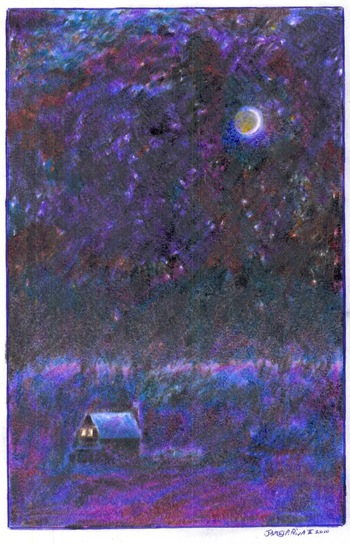What Prisoners Create When They Create Art
This is the second in a three-part series about what Massachusetts prisoners do online. Today we look at the intersection of art and language. Or, you can read Part 1: What Massachusetts Prisoners Blog About.
 Artwork by James Riva / posted at Between the Bars
Artwork by James Riva / posted at Between the Bars
For 32 years, James Riva, 55, has been incarcerated at Old Colony Correctional in Bridgewater, Mass., serving a life sentence for murder. Riva says he collects 300 to 400 four-leaf clovers every summer and dries them. “They bring no good luck or bad” but they give him some “peace,” he writes at betweenthebars.org, the blog founded by two MIT whiz kids.
In one of Riva’s 12 or so posts, he wrote a short story about a disturbing relationship between a mother and son that includes the details of a brutal crime. But while his haunting words paint an image, the artwork that accompanies the story shows the mystery, power, and transcendence of art. Perhaps influenced by Vincent Van Gogh’s Starry Night, it hasn’t received a comment yet, but when it does, Riva can interact with the outside world—online.
Creating art and sharing it with the world is a way for prisoners to assert themselves back into humanity. As Supreme Court Justice’s Thurgood Marshall wrote about prisoner rights: “When the prison gates slam behind an inmate, he does not lose his human quality … nor is his quest for self-realization concluded.”
In a paper titled, “Mediative Collaborative Positioning: The Case of Prisoner Blogs,” researchers Mirjana Dedaic and Katherine Dale write that blogs “open a new space” for prisoners while giving them the chance to challenge their confinement by “stepping beyond the bars” into cyberspace. There, they can be educators, critics, analysts, storytellers, and in the case of art, they’re seen for their talent instead of for their crimes.
Luis Perez, also in prison for life, is incarcerated at MCI Gardner, Mass., and often uses art to transmit a message. His art is fanciful while his message is deadly serious:

Artwork by Luis Perez / posted at Between the Bars
Perez has received comments from activists about his writing and art. “J” replies: “A lot of what you said really resonated with me and my experience. Thanks for sharing your wisdom.”
Art Behind Bars is not new, but posting art online has allowed prison artists to share their work to people all over the world. Lois Ahrens from Northampton, Mass., maintains a website at realcostofprisons.org, where she receives more than 750,000 unique visits a year and has pioneered posting prisoners’ comics.
With 25 comics at realcostofprisons.org/comix/barrett, Jacob Barrett evokes the power of an image to decry imprisonment and injustice. He also has a website, maintained by loved ones, where he posts: “I am in search of people who will free my mind of this hold, even though my body will remain restrained.”
 Artwork by Jacob Barrett / posted at Real Cost of Prisons
Artwork by Jacob Barrett / posted at Real Cost of Prisons
Another pioneer in Massachusetts is Jason Lydon, director of Black and Pink, whose website features LGBTQ artists with their profiles and posted art. Black and Pink connects LGBTQ prisoners to allies on the outside and also has a newsletter filled with the reality of being behind bars and being LGBTQ.
One artist, who calls herself “Billie Jean Star” says on black and pink art: “My mind is constantly formulating new ideas even in my dreams during actual sleep. That’s why I call my artwork “Daydream Productions Ltd.” Because they represent only a few of my constantly repeated, conscious imaginations.
 Art by Billie Jean Star (alias) / posted at Black and Pink Art
Art by Billie Jean Star (alias) / posted at Black and Pink Art
With blogging, Billie Jean, like 95 percent of incarcerated prisoners, is also preparing for the new world of social media which she will enter when she returns to civilian life.


